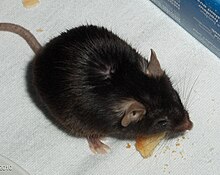Mus musculus domesticus, the Western European house mouse, is a subspecies of the house mouse (Mus musculus). Some laboratory mouse strains, such as C57BL/6, are domesticated from M. m. domesticus.[1]
| Mus musculus domesticus | |
|---|---|

| |
| A female C57BL/6 laboratory mouse, which is domesticated from Mus musculus domesticus.[1] | |
| Scientific classification | |
| Domain: | Eukaryota |
| Kingdom: | Animalia |
| Phylum: | Chordata |
| Class: | Mammalia |
| Order: | Rodentia |
| Family: | Muridae |
| Genus: | Mus |
| Species: | |
| Subspecies: | M. m. domesticus
|
| Trinomial name | |
| Mus musculus domesticus Schwarz and Schwarz, 1943
| |
Distribution
editIn Europe, M. m. domesticus lives in Western and Southern Europe, while another subspecies, the Eastern European house mouse (M. m. musculus) lives in Eastern and Northern Europe.[2] The area from Scandinavia to the Black Sea is a secondary hybrid zone for M. m. domesticus and M. m. musculus.[3] Habitats of M. m. domesticus also exist in the Middle East, Southern Asia, North Africa, North America, and some areas of Latin America and Oceania.[4]
Relations with humans
editM. m. domesticus is harmful to humans, for they can damage vegetation and field crops. It is also one of many invasive species.[4][5]
References
edit- ^ a b Gardiner, Jennifer R.; Swain, Amanda (2015). "Sex Determination and Differentiation". Knobil and Neill's Physiology of Reproduction (4th ed.). Academic Press. pp. 267–292. doi:10.1016/B978-0-12-397175-3.00007-7. ISBN 978-0-12-397175-3.
- ^ Alena Fornůsková; Zuzana Hiadlovská; Miloš Macholán; Jaroslav Piálek; Joëlle Goüy de Bellocq (October 2021). "New Perspective on the Geographic Distribution and Evolution of Lymphocytic Choriomeningitis Virus, Central Europe". Emerging Infectious Diseases. 27 (10): 2639. doi:10.3201/eid2710.210224. PMC 8462312.
- ^ Kváč, Martin; McEvoy, John; Loudová, Martina; Stenger, Brianna; Sak, Bohumil; Květoňová, Dana; Ditrich, Oleg; Rašková, Veronika; Moriarty, Elaine; Rost, Michael; Macholán, Miloš; Piálek, Jaroslav (2013). "Coevolution of Cryptosporidium tyzzeri and the house mouse (Mus musculus)". International Journal for Parasitology. 43 (10): 805–817. doi:10.1016/j.ijpara.2013.04.007. ISSN 0020-7519. PMC 4437667. PMID 23791796.
- ^ a b "Mus musculus domesticus (mouse)". CABI. Retrieved 2019-02-01.
- ^ Lippens, C; Estoup, A; Hima, M K; Loiseau, A; Tatard, C; Dalecky, A; Bâ, K; Kane, M; Diallo, M; Sow, A; Niang, Y; Piry, S; Berthier, K; Leblois, R; Duplantier, J-M; Brouat, C (2017). "Genetic structure and invasion history of the house mouse (Mus musculus domesticus) in Senegal, West Africa: a legacy of colonial and contemporary times". Heredity. 119 (2): 64–75. doi:10.1038/hdy.2017.18. ISSN 0018-067X. PMC 5564374. PMID 28353686.